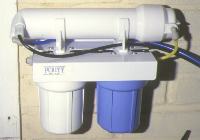 One of the joys of marine fishkeeping has to be the ability to up-grade a system at any time using one, or a combination, of new pieces of equipment. Not only does this have the effect of improving the environment of expensive livestock but it also brings about a certain self-satisfaction knowing that your pets are receiving the best possible attention.
One of the joys of marine fishkeeping has to be the ability to up-grade a system at any time using one, or a combination, of new pieces of equipment. Not only does this have the effect of improving the environment of expensive livestock but it also brings about a certain self-satisfaction knowing that your pets are receiving the best possible attention.
Sometimes it seems that a new product hits the market every few days but usually it is a familiar concept re-arranged in new packaging. Just occasionally though, a really new idea is presented to the hobbyist which does not cost a fortune and performs a useful purpose. However, it has to be said that most of the items I am about to list require a certain amount of investment and it would be wise to compare several makes, not only for quality but also value for money.
This overview is meant as a guide to what is available and NOT a list of what every marine aquarium should have! It is by no means complete. Some items are essential from the start, such as the protein skimmer and possibly the ultra-violet steriliser; many others can be added later as more experience is gained and funds become available.
There are four categories: Essential Equipment (all basic marine aquaria should have this), Highly Recommended (very useful, labour saving and well worth the investment), Recommended (useful equipment, worth considering), Not Essential (equipment that can be added at a later date, or as the system requires).
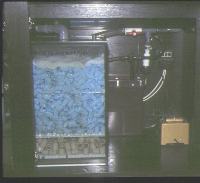 Trickle Filters (Recommended)
Trickle Filters (Recommended)
The principle of trickle filtration is simplicity itself. Aquarium water is sprayed over a bacteria-friendly media. Here, in the presence of masses of atmospheric oxygen, aerobic (oxygen-loving) bacteria get to work on toxic ammonia and nitrite. Unrestricted by the amount of dissolved oxygen available to them, nitrobacter and nitrosomonas bacteria survive and multiply far beyond the numbers to be found in traditional undergravels.
Trickle filters are endlessly versatile and may be designed as features to position over the top of the tank, on the side of the tank, below the tank, or even within the tank itself.
Below the tank models usually facilitate the greatest numbers of 'extras' as all the equipment is contained within a sump in which space is provided for protein skimmers etc. The beauty of the trickle system is that practically all working equipment is out of sight and exceptionally accessible for maintenance purposes.
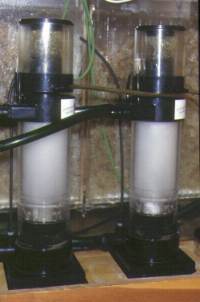 Protein Skimmers (Essential Equipment)
Protein Skimmers (Essential Equipment)
If you keep marines and are unfamiliar with the protein skimmer, now is the time to seriously consider this vital piece of marine equipment.
Like all really useful things, the skimmer is simple in operation. Basically, into a tube of aquarium water, millions of tiny bubbles are introduced either by an air pump and wooden air diffuser or venturi water pump. On the interface between the air in the bubbles and the water, various waste products are attracted and 'fixed'. As the bubbles rise, they shed their cargo of waste into a collecting cup or container to be easily disposed of.
Models may be sited underneath, inside, over the top, or beside the tank; and power may vary from a simple airpump to a powerful water pump.
Make no mistake, if your tank is without this essential item, water changes will need to be more frequent and far heavier to maintain reasonable water quality.
Surface Skimmers (Not Essential)
All aquarists at some time or another have had an annoying scum on the surface of the water. Whether formed by algae or proteinous oily substances, a surface skimmer may be the answer. A sealed container with an open top is placed in the aquarium. The open top is positioned just under the surface of the water and the inlet to a pump or canister filter is placed into the container. As water is withdrawn from the container, it is replaced by surface water and the accompanying scum.
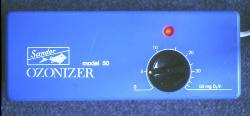 Ozoniser (Not Essential)
Ozoniser (Not Essential)
The ozoniser is inextricably linked to the protein skimmer as it is just about the only safe way to use ozone in the marine aquarium.
Ozone (O3) is an unstable gas generated by a high voltage electrical field. It has the ability to oxidise organic waste and many inorganic substances, thus cleaning any water it comes into contact with. As a result. redox potential is increased to favourable levels.
Under no circumstances must ozone be directly introduced into the aquarium as it has the ability to destroy invertebrates and seriously damage the gills of fish. Therefore, it must be contained within a protein skimmer and any excess ducted away or filtered through activated carbon.
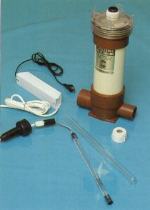 Correct dosing using a straight ozone generator is not easy as there is no real measurement of what is going on, and this is where the next item becomes useful.
Correct dosing using a straight ozone generator is not easy as there is no real measurement of what is going on, and this is where the next item becomes useful.
Ultra-Violet Steriliser (Highly Recommended)
Ultra-violet light has the ability to seriously damage or kill free-swimming disease organisms. This fact has an obvious and ideal application within the confines of an marine aquarium which can rapidly become overrun by harmful diseases such as whitespot and Oodinium. Even a relatively small UV fluorescent tube encased in a watertight housing is capable of preventing or controlling potentially lethal situations.
As a bonus, cloudy water caused by bacteria or algal blooms can be cleared very effectively. A suitable canister filter to act as pump and pre-filter will be needed to operate the steriliser and the ultra-violet tube will need replacing every six months.
Redox Meter/Controller (Not Essential)
Redox potential, also known as ORP (Oxygen Reduction Potential) is, put rather simplistically, a measurement of the ability of water to cleanse itself. It is measured in millivolts (mV) and an efficient aquarium will operate at between 350 - 450 mV. The only way of directly influencing this reading to keep it stable is to introduce ozone. A redox meter/controller will not only tell you, by means of a probe, what the redox potential is, but can also be set to switch the ozoniser on or off, so that a desired level may be maintained.
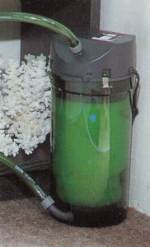 Canister Filters (Highly Recommended)
Canister Filters (Highly Recommended)
As the name implies, this is a simple external canister with a pump attached. Familiar to most hobbyists, this useful item can be used in a multitude of ways; not only packing with various types of media but running reverse-flow filtration or trickle filters.
Denitrification/Nitrate Filters (Recommended)
A controlled area of virtually still, de-oxygenated water will encourage anaerobic bacteria to flourish. These bacteria have the ability to convert nitrates into free nitrogen gas, thus keeping aquarium nitrate levels constantly low.
Denitrification (as the process is termed) filters can be fitted as an integral part of an overall systemised aquarium or as an addition.
Residual Voltage Disperser (Recommended)
Take a piece of copper wire, solder it to a length of stainless steel and you have a residual voltage disperser - well, almost. The idea is that the bent stainless steel rod hangs on the side of the tank with the tip submerged below the water. The other end of the copper wire is connected to a suitable earth point. In this way, any residual static electricity current that has built up in the aquarium due to the close proximity of lights, heater and pumps etc., is quickly dispersed safely to earth, therefore, reducing the risk of electric shock or minor 'tingles' to negligible levels.
There is also some evidence that residual current within an aquarium may stress fish and invertebrates, causing disease and premature death. This device should eliminate that risk, for which it was primarily designed. However, I think that the added electrical safety factor may prove to be far more important.
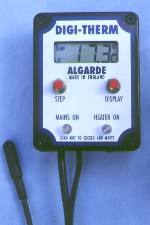 Digital Thermostats (Recommended)
Digital Thermostats (Recommended)
As all marinists should know, the stability of water parameters is of the utmost importance and none more so than temperature.
A digital thermostat has the ability to control either undertank heating mats or conventional immersion heaters with a great deal of accuracy, i.e. to within one tenth of a degree C. Most models are fitted with a rotary control but only the more expensive ones have a digital readout.
Digital Thermometers (Recommended)
If you would like to know the temperature of your aquarium water to a tenth of a degree then a digital thermometer can be purchased for a relatively small investment. A small probe is suspended into the water and an LED reading reveals all.
Heating Mats (Recommended)
Undertank heating mats are gaining in popularity with the aquarist and have proved reliable and effective. They need to be used in conjunction with an external thermostat but apart from that, remain entirely hidden.
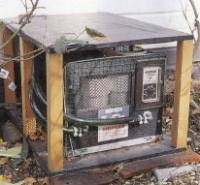 Chillers (Recommended)
Chillers (Recommended)
Chillers are especially useful where the ambient temperature of the room can expect to exceed that safely recommended for the aquarium. They are best positioned outside the house to let the excess heat drawn from the aquarium escape properly. Chillers for the marine aquarium must be specially constructed so that the saltwater will neither be contaminated nor piping corroded by it.
Osmolators (Highly Recommended)
Freshwater is constantly evaporating from all fish tanks, especially tropical. Marine tanks are particularly affected because the salt remains behind becoming more and more concentrated and possibly stressing livestock. An osmolator can call on a freshwater reservoir and replace any evaporation immediately. Therefore, the salinity remains extremely stable.
Oxygen Reactors (Not Essential)
Oxygen reactors usually form part of sophisticated external trickle filters and are placed in the sump. A sealed cylinder filled with a very porous plastic media is slightly pressurised and water from the aquarium is introduced. Oxygen is resultantly 'forced' into the water creating a saturated solution.
Carbonate Hardness Reactor (Not Essential)
These work in exactly the same way as the above, except that the cylinder is fitted with small pieces of calcareous rock.
Calcium Reactor (Not Essential)
By lowering the pH in a reactor chamber containing calcium chips, the water passing through it is enriched with calcium. Carbon dioxide gas is used in the chamber to reduce the pH significantly enough for the calcium to pass into solution. A very useful piece of equipment where calcium levels are required to be high and stable, such as in a reef tank containing hard corals.
Kalkwasser Doser (Not Essential)
Calcium hydroxide when added to the marine aquarium will increase the calcium content and keep pH levels stable. A chamber is used to mix the calcium hydroxide powder and the tankwater into a milky solution. This is then added to the main tank water at a dose controlled by a pH meter. Should the pH rise too high, the supply is cut off. The same method can be applied to the calcium reactor.
Automatic Metering Pump (Not Esential)
This enables additives or medications to be added to the tank in a constant metered dose.
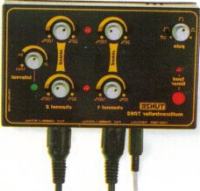 Wave/Surge Controllers (Recommended)
Wave/Surge Controllers (Recommended)
This electrical box of tricks can control several circulatory pumps which may be placed at different levels of the aquarium. They are automatically switched on or off to create varying patterns of current within the water volume.
It can be set to mimic tidal turbulence and give a very natural effect which livestock seem to thrive in. These devices are not for use on pumps running biological filters as they could create problems by disturbing the flow of oxygen-rich water to the beneficial bacteria.
Lighting Timers (Highly Recommended)
As the name implies, this useful device controls the lighting periods automatically. Several sets of lights can be pre-programmed to give a sunrise - sunset effect, or even a moonlight scene.
Feeding Timers (Not Essential)
Another electrical control device that is very similar to the above. However, it either reduces or stops the flow from all pumps whilst feeding is taking place. This prevents food from being dragged into the filters before it can be eaten. After a pre-set period of time, flow rates are restored to normal automatically.
![]() Multi-Controllers (Recommended)
Multi-Controllers (Recommended)
With the many recent advancements made in computing technology, aquarium multi-controllers have been developed to take charge of a host of functions.
pH, redox, pumps, lighting, temperature, etc., can all be displayed/controlled from one small box no larger than a paperback book!
Heaps of wiring packing a cupboard are a thing of the past, as pulses are sent down the house electrical supply to activate remote units. In addition, the whole thing can be monitored and programmed from an ordinary PC. Where will it end!?
 Reverse Osmosis Units (Highly Recommended)
Reverse Osmosis Units (Highly Recommended)
The trouble with domestic tapwater is that it is usually contaminated with nitrates, phosphates, silicates, pesticides, etc., all excellent nutrients for nuisance algae, as well as a poor source of make-up water. All of these problems can be overcome with the use of a reverse osmosis unit. 95-98% of all impurities can be filtered out using one of these units and they are fast becoming standard equipment for most marinists. If you require high quality make-up water, then you need an RO unit!
© Nick Dakin. May not be used, in whole or part, without permission.

